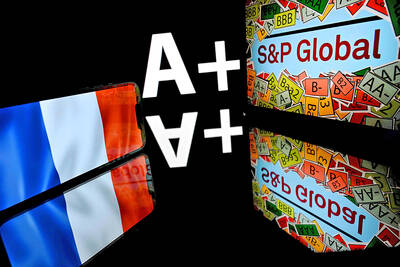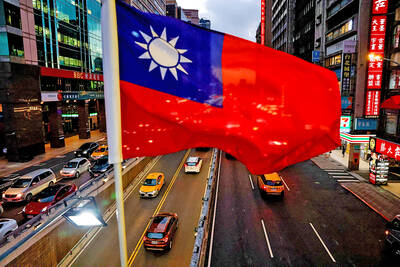Engineers and researchers have for many years dreamed of a world in which people could share immense computing power and data storage to improve the way they work.
Sun Microsystems Inc and National Central University (NCU) yesterday moved to realize that dream by establishing Taiwan's first grid-computing laboratory.
Grid, or distributed, computing emerged about five years ago and links hundreds or even thousands of computers to enable the sharing, selection and aggregation of a wide variety of geographically distributed computational resources. The technology aims to provide vast computing power or data storage to companies who pay only for what they use.
"So far, grid computing is mostly applied to the research domain -- such as civil engineering, the environment and such things -- but I'm sure it will be used in commercial computing in the next few years," Dinesh Bahal, director of Sun's global education and research in the Asia-Pacific region, said at a signing ceremony yesterday. "In short, it will change our way of working and doing business."
For the first three years of the cooperation, Sun and NCU will pump in NT$100 million in the Grid Computing Center.
The center will initially be used in NCU research projects for space remote sensing, optics, environment, communication systems and nanotechnology, said Chiang Wei-ling (
NTC also plans to invite institutions including National Tsing Hua University and National Chiao Tung University to participate in research, Chiang said.
"I think the cooperation will make us one of the world's top 500 universities in the high-performance computing field," he said.
Sun has already joined several other institutes, including the University of California, San Diego, in the US, the University of Ulm in Germany and the High Performance Computing Virtual Laboratory in Canada -- to develop grid computing technology.
"Grid computing is the most influential information technology in this century," said Alan Chang (張鴻瑜), general manager of Sun Microsystems Taiwan. "Currently, the utility rate of workstations, storage facilities and servers on the Internet is 5 percent to 20 percent on average, and with grid computing, it will drive up the rate to 98 percent, which will help to resolve a lot of complicated computing in a short time."
A pioneer in the field is SETI@home, a never-ending search for signs of life from space that began in the 1990s. The program uses idle computers to process data picked up by radiotelescopes.
Another example is the IBM/Oxford eDiamond project in Britain, which is a part of the government's "e-science initiative," helping doctors detect and treat breast cancer with five hospitals or screening centers sharing a grid.
In 2002 in Taiwan, IBM Corp, Academia Sinica and National Yang-Ming University built a biotechnology research center powered by grid computing provided by IBM. The grid connected seven biological institutions with a goal to expand the grid to more than 100 within three years.
IBM signed a similar research pact with National Cheng Kung University last year.

France cannot afford to ignore the third credit-rating reduction in less than a year, French Minister of Finance Roland Lescure said. “Three agencies have downgraded us and we can’t ignore this cloud,” he told Franceinfo on Saturday, speaking just hours after S&P lowered his country’s credit rating to “A+” from “AA-” in an unscheduled move. “Fundamentally, it’s an additional cloud to a weather forecast that was already pretty gray. It’s a call for lucidity and responsibility,” he said, adding that this is “a call to be serious.” The credit assessor’s move means France has lost its double-A rating at two of the

Jensen Huang (黃仁勳), founder and CEO of US-based artificial intelligence chip designer Nvidia Corp and Taiwan Semiconductor Manufacturing Co (TSMC, 台積電) on Friday celebrated the first Nvidia Blackwell wafer produced on US soil. Huang visited TSMC’s advanced wafer fab in the US state of Arizona and joined the Taiwanese chipmaker’s executives to witness the efforts to “build the infrastructure that powers the world’s AI factories, right here in America,” Nvidia said in a statement. At the event, Huang joined Y.L. Wang (王英郎), vice president of operations at TSMC, in signing their names on the Blackwell wafer to

AI BOOST: Although Taiwan’s reliance on Chinese rare earth elements is limited, it could face indirect impacts from supply issues and price volatility, an economist said DBS Bank Ltd (星展銀行) has sharply raised its forecast for Taiwan’s economic growth this year to 5.6 percent, citing stronger-than-expected exports and investment linked to artificial intelligence (AI), as it said that the current momentum could peak soon. The acceleration of the global AI race has fueled a surge in Taiwan’s AI-related capital spending and exports of information and communications technology (ICT) products, which have been key drivers of growth this year. “We have revised our GDP forecast for Taiwan upward to 5.6 percent from 4 percent, an upgrade that mainly reflects stronger-than-expected AI-related exports and investment in the third

RARE EARTHS: The call between the US Treasury Secretary and his Chinese counterpart came as Washington sought to rally G7 partners in response to China’s export controls China and the US on Saturday agreed to conduct another round of trade negotiations in the coming week, as the world’s two biggest economies seek to avoid another damaging tit-for-tat tariff battle. Beijing last week announced sweeping controls on the critical rare earths industry, prompting US President Donald Trump to threaten 100 percent tariffs on imports from China in retaliation. Trump had also threatened to cancel his expected meeting with Chinese President Xi Jinping (習近平) in South Korea later this month on the sidelines of the APEC summit. In the latest indication of efforts to resolve their dispute, Chinese state media reported that